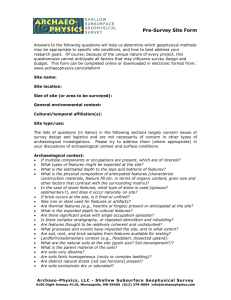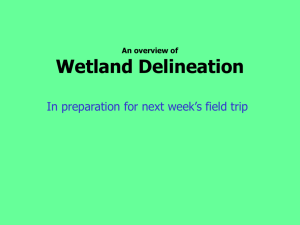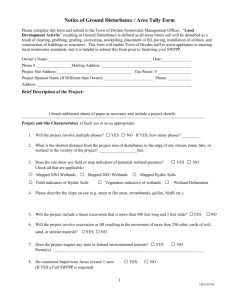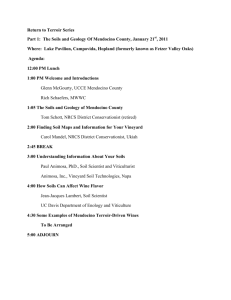Training - Soil and Water Science
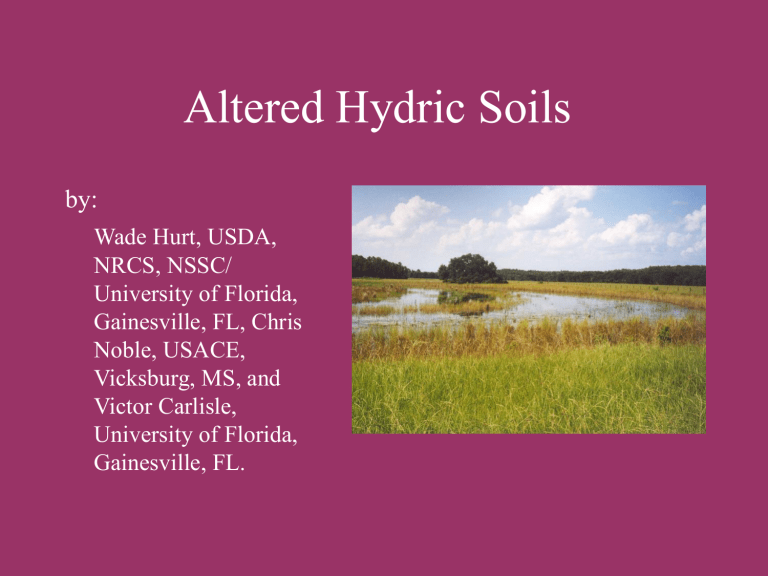
Altered Hydric Soils
by:
Wade Hurt, USDA,
NRCS, NSSC/
University of Florida,
Gainesville, FL, Chris
Noble, USACE,
Vicksburg, MS, and
Victor Carlisle,
University of Florida,
Gainesville, FL.
Types of Altered Hydric Soils
Artificial
Drained (Protected)
Historic
Relict
• The objectives of this lecture are to outline criteria used to identify each of these alterations and to outline the impact of alterations on the hydric status of a soil.
Development of Altered Soils
Hydrologic modification may result in:
•
1. Artificial Hydric Soils
• 2. Drained (Protected) Hydric Soils.
Soil modification may result in:
•
1. Artificial Hydric Soils
• 2. Historic Hydric Soils
•
3. Relict Hydric Soils
Hydrologic Modification
Hydrologic modification results where saturation and/or inundation (ponding or flooding) has been changed by human or geologic processes.
Both geologic modifications and human modifications of hydrology may change the hydric status of a soil.
Soil Modification
Soil modification result where soils (not hydrology) have been altered either through geologic or human additions or removals.
Both geologic modifications and human modifications of a soil may change the hydric status of a soil.
Key
Hydric Soils are currently supporting or capable of supporting wetland ecosystems. Soil modifications are not needed to maintain or restore a wetland. In the case of drained hydric soils, only removal of hydrologic modifications are needed to restore wetlands.
Nonhydic soils currently are not supporting nor are they capable of supporting wetland ecosystems. Soil modifications are needed to create a wetland. Hydrology modifications may also create a wetland on nonhydric soils. The differences between creation and restoration will be discussed layer.
Review: Why is a Soil Hydric
A soil is hydric because it:
•
1. Has a hydric soil indicator, or
•
2. Meets hydric soil criteria 3 or 4, or
•
3. By data meets the Hydric Soil
Technical Standard (HSTS).
Artificial Hydric Soils
Wetness of these altered soils has been increased by human activities (constructed wetlands, irrigation leaks, rice fields, lake skeins and other construction activities) or the soils have been altered by human activities (constructed wetlands, pond fringes and other excavations).
These altered soils are hydric soils because they:
• 1. Have a hydric soil indicator, or
• 2. Meet hydric soil criteria 3 or 4, or
• 3. By data meet the HSTS.
Artificial Hydric Soil
This dug pond has an artificial hydric soil fringe that was created when the pond was constructed. It now supports a wetland ecosystem.
Artificial Hydric Soil
The wetland shown here and on the first slide was created by removing soil material from a nonhydric soil.
The resulting soil is an
Artificial Hydric Soil.
Artificial Hydric Soil
Construction activities, note the railroad in the background, may be the reason wetlands and hydric soils exist here.
Drained (Protected) Hydric Soils
This is the 2nd type of altered hydric soils: An attempt through human activities to decrease the wetness of these altered soils has been made
(ditches, levees, dams, pumps, etc.).
Even with reduced wetness these altered soils maintain their hydric status because they:
•
1. Have a hydric soil indicator or,
• 2. Meet hydric soil criteria 3 or 4 or,
•
3. By data meet the HSTS.
Ditches, levees, dams, pumps, etc., do not alter the hydric status of a soil.
Drained Hydric soils
The concept of drained hydric soils maintaining their hydric status should be thoroughly understood. This is important to wetland scientist. By recognizing a soil with a hydric soil indicator as being hydric regardless of hydrologic alteration we keep soils capable of supporting wetlands (if hydrology was restored) in the same class as soils that are currently supporting wetlands.
I have seen areas ditched, pumped, and protected by levees in the Mississippi delta that are in crop production (soybeans) that are still not drained hydric soils because they still pond water for up to one month during the growing season, still have a hydric soil indicator, and still meet the HSTS. One can hardly never underestimate the effect of ditches upon the hydric status of a soil.
In normal circumstances a wetland requires the presence of three criteria
(wetland hydrology, wetland vegetation, and hydric soils). For an area to be a wetland each of these criteria are met independently.
Historic Hydric Soils
This is the 3rd type of altered hydric soils: These altered soils have had additional soil material placed on top of the original soil by human activities to the extent that that they are no longer hydric (1993 flooding deposition on the Missouri River flood plain, filling a wetland). The additions may be intentional
(illegal fill) or non intentional (erosional deposition).
These altered soils are nonhydric because they:
•
1. Do not have a hydric soil indicator and,
•
2. Do not meet hydric soil criteria 3 or 4 and,
•
3. Do not, by data, meet the HSTS.
Historic Hydric Soils are altered soils that were once hydric but have had human modifications
(additions) such that they are no longer hydric. The additions may be intentional
(illegal fill) or non intentional (erosional deposition).
Nonhydric Hydric
15 cm
Historic Hydric Soils
Even though fill material has been placed over the entire soil area shown in the previous slide it has areas that are still hydric as well as areas that are no longer hydric. The area to the right of the vertical arrow is still hydric even though fill material has been placed on the surface: it has the HS Indicator S6 (Stripped Matrix) starting within 15 cm (6 inches) of the surface. The lower horizontal arrow indicated where the stripped matrix starts. The soil area to the left of the vertical arrow still has a stripped matrix but it starts below the depth required
(15 cm) by the HS Indicator S6 (Stripped Matrix).
Can you think of other ways (other than the presence of a HS
Indicator) that a soil can be proven to be hydric? What about monitoring to see if it floods or ponds long enough to satisfy Criteria 3 or 4 or monitoring to see if it meets the HSTS?
Channelization and the resulting spoil may change the hydric status of a soil. Also the surrounding area may have reduced wetness.
Areas which may have changed from hydric to nonhydric.
Culvert
Historic Hydric or Still Hydric?
Depleted Matrix starts here
Historic?
The soil in the previous slide has had fill material placed over the original soil.
The knife blade points to the limit of the 10YR 5/4 fill material (24 cm). The blue arrow points to the start of HS indicator F3, Depleted Matrix (28 cm).
This “new” soil is nonhydric because the depleted matrix does not start within
25 cm and because the fill material has a chroma of 4. This is a Historic
Hydric Soil.
What if the same fill material was only 18 cm thick over the same underlying soil? This means the depleted matrix would start at 22 cm. Would the soil be hydric or nonhydric? This new soil would still be nonhydric. Remember the introductory “ Unless otherwise indicated,all mineral layers above any of the Indicators have dominant chroma 2 or less,or the layer(s)with dominant chroma of more than 2 is less than 15 cm (6 in)thick” (Hurt, et al. 2002, p.5). It would still be a Historic Hydric Soil.
In this example the fill material would have to be less than 15 cm (6 in) thick for the soil to be a hydric soil.
Relict Hydric Soils
This is the 4th type of altered hydric soils: These altered soils were once hydric but are no longer hydric due to geologic activities (pimple mounds of Texas
Gulf Coast Prairie, stream downcutting).
Only on close examination is it evident that hydric soil morphologies do not exist.
These altered soils are nonhydric because they:
•
1. Do not have a hydric soil indicator and,
•
2. Do not meet hydric soil criteria 3 or 4 and,
•
3. Do not, by data, meet the HSTS.
Relict Hydric Soils
Several morphological characteristics can suggest relict redoximorphic features
(Vepraskas, 1994). These are:
•
1. Feature type and boundary characteristics,
•
2. Location to macropores,
•
3. Redox feature color, and
•
4. Pore lining continuity.
1. Feature and Boundary Characteristics
A. Nodules and concretions:
B. Other redox concretions.
1 A: Nodules and Concretions Feature and Boundary Characteristics
Contemporary nodules and concretions have:
•
1. Diffuse boundaries (the color grade is commonly more than 2 mm wide),
•
2. Irregular surfaces, and
• 3. If smooth and round surfaces, red to yellow corona
(halos) should be present.
Relict nodules and concretions may have:
• 1. Sharp boundaries (color grade is commonly less than
0.1 mm wide) and
• 2. Smooth surfaces.
Relict Features
These redoximorphic features (nodules) most likely are relict because they have sharp boundaries and smooth surfaces.
(photograph Vepraskas. 1994)
1 B: Other Redox Concentrations
Feature and Boundary Characteristics
Contemporary redox concentrations have diffuse boundaries.
Relict redox concentrations may have sharp boundaries.
Contemporary redox concentrations have diffuse boundaries.
Relict redox concentrations may have sharp boundaries.
3 cm
1 cm
2: Redox Macropore Features
Contemporary macropores may have:
•
Fe depletions along stable macropores in which roots repeatedly grow that are not overlain by iron rich coatings.
Relict macropores may have:
• Fe depletions along stable macropores in which roots repeatedly grow that are overlain by iron rich coatings.
3: Redox Color Features
Contemporary redox colors may be the results of the iron minerals:
•
1. Ferrihydrite (5YR), Lepidiocrocite (7.5YR),
Goethite (7.5YR, 10YR), and Jarosite (2.5Y) and
•
2. Have value and chroma 4 or more.
Relict redox colors may be the results of the iron mineral:
•
1. Hematite (10R, 5R, 2.5YR) and
•
2. Have value and chroma <4.
4: Pore Lining Continuity
Contemporary pore linings may be continuous especially around living roots. Relict pore linings may be broken and unrelated to live roots.
Pictured below is a continuous pore lining (reddish area) parallel to a reduced area (blue-green).
Relict Hydric Soils: Texas Gulf Coast Prairie
Present Land Surface Geologic Land Surface
Geologic Hydric Soil Boundary
Telferner
Present Hydric Soil Boundary
Nada, Dry
Nada, Wet
0-10 cm lfs
10YR 5/3
10-29 cm sc
10YR 5/2 cd 10R 3/3 cd = common distinct fd = few distinct
0-19 cm fsl
10YR 4/2
19-27 cm scl
10YR 4/2 fd 7.5YR 4/6
0-12 cm fsl
10YR 4/2
12-29 cm scl
10YR 4/2 cd 7.5YR 4/6
2m
Cieno
0-10 cm l
10YR 5/3 cd 7.5YR 4/6
10-25 cm sl
10YR 5/2 cd 7.5YR 4/6
Relict Hydric Soils: Texas Gulf Coast Prairie
The landscape depicted in the previous slide shows an area where climatic changes have made what once was the lowest area
(Telferner soils) is now the highest area.
Only by close examination do we know that the Telferner soils are now relict hydric soils; the redox concentrations are 10R 3/3. cd = common distinct and fd = few distinct
Fill
Redox features forming
Original surface
Time and the formation of redox features
The soil shown on the previous slide has fill material about 10 inches thick placed over the original soil that had a depleted matrix.
The fill material had been in place for only a few years and redox features are forming in the lower ½ of the fill material indicating that in a few more years a hydric soil indicator would be present in the new soil.
Summary
The types of Altered Hydric Soils are Artificial, Drained
(Protected), Historic, and Relict hydric soil. Artificial hydric soils were once nonhydric but now are hydric soils: created by human modifications to hydrology (additional water) or soil
(removal of soil). Drained hydric soils were hydric and still are hydric soils: created by human modifications to hydrology.
Historic hydric soils were once hydric but are now nonhydric soils: created by geologic or human modifications to soils
(additions). Relict hydric soils were hydric but are now nonhydric soils: created by geologic modifications to hydrology.
A soil is hydric because it: (1) Has a hydric soil indicator or, (2)
Meets hydric soil criteria 3 or 4 or, (3) By data meets the HSTS.
Caveats
Modified soil and hydrology may be due to illegal or legal activities.
By federal or state agency policy, modified areas may be subject to litigation (Section
404 CWA, Swampbuster) or still eligible for programs (USDA’s EWP).
Literature Cited
Hurt, G.W., and L.M. Vasilas (Eds.). 2006. Field indicators of hydric soils in the United States (Version 6.0),
USDA, NRCS, Fort Worth, TX. http://soils.usda.gov/soil_use/hydric/field_ind.pdf
Vepraskas, M. J. 1994. Redoximorphic Features for
Identifying Aquic Conditions. Tech. Bulletin 301. North
Carolina Ag. Research Service, North Carolina State Univ.,
Raleigh, North Carolina.




